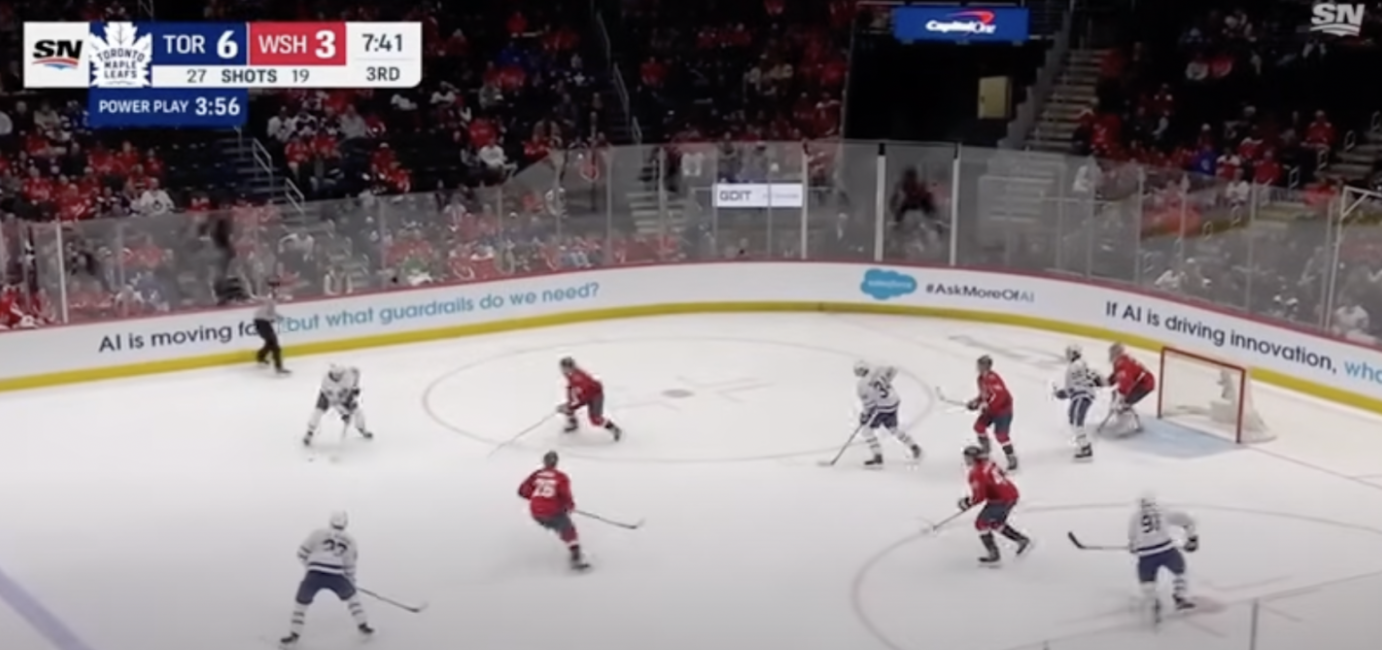In February, the Maple Leafs posted the best power-play percentage in the NHL, tying a league record with a 50% success rate. In March, the man advantage took a complete 180, finishing 30th in the league at 9.1 percent.
Overall, in the last month, the Leafs played 14 games, scored four power-play goals on 44 power plays, and gave up one shorthanded goal for a +3 goal differential.
It’s a troubling sign for a Leafs team whose power play has essentially fallen off a cliff every spring under Sheldon Keefe other than last year’s playoffs when they finally won a round (no coincidence there). Through Keefe’s four seasons in Toronto so far, this is how it has shaken out:
| Season | Regular Season PP% | Playoff PP % | Difference |
|---|---|---|---|
| 2022-23 | 26 | 25 | -1 |
| 2021-22 | 27.3 | 14.3 | -13 |
| 2020-21 | 20 | 13 | -7 |
| 2019-20 | 23.1 | 15.4 | -7.7 |
Whether this is a sign of things to come or a blip in the road is the big question. That answer will naturally play itself out over time, but we can look at some of the issues in the meantime in an effort to sort out what’s gone wrong.
Let’s start by looking back to their power play in February when it was rolling. I reviewed all 14 goals in their 14-for-28, and of those goals, I’d classify eight as resulting from a down-low play. Two came in the bumper – one was a Matthews one-timer against the Flyers, one was a tip from Tavares, one was a Nylander shot from the faceoff circle that arguably also started off a down-low sequence, and one was a 5v3 goal (a different circumstance, but I’d also argue it was a down-low sequence).
Compare this to March when the Leafs scored only four power play goals – two came off the rush, one was a tip by Nylander, and the other was a snipe by Nylander. The obvious difference is the lack of a goal originating from any sort of down-low play.
Flipping through their power plays in February, the sequence that sums up the Leafs at their best on the power play is this goal against the Avalanche:
The Leafs power play is left-justified, with Nylander’s great shot set up on his off-side. Marner is down low on his off-side open and ready as a passing outlet should the opposition push up on Nylander. If we pause it before the creation of the down low 2v1, Nylander holds the puck for a second to sell a shot, the PK freezes, and Marner is already winding up for 2v1 situation down low. This is about as easy of a pass as there is for Marner and an easy finish for Bertuzzi.
When Marner possesses it down low and the PK drops two defenders back to take away the 2v1 down low, it opens up the time and space up top for the Leafs’ two big-time shooters to tee off, which can result in goals like this:
Before the up-top sequence, look at how the Stars have two defensemen down low in more of a “box” formation, leaving all sorts of time and space up top for Nylander to grab the puck and go back and forth with Morgan Rielly before scoring.
Generally speaking, the Leafs want to run the power play through Nylander’s stick on the half-wall, which makes sense – he leads the team with 34 power-play points (the next closest is Matthews with 26). But right now, Nylander is often stranded with no passing outlets, which is exactly what Marner provides as a righty (and is why the coaching staff immediately wanted to replace Marner with Calle Jarnkrok before Jarnkrok also got injured).
This is a common look for Nylander right now:
What is #88 supposed to do here? Try to shoot it through shinpads in the hopes that it gets to the net? He has no down-low passing outlet, and in fact, earlier in this power play when Tavares did shift down, he took the pass on his backhand before giving it away.
If we go through their power plays over the past few weeks, opposing penalty kills have pushed right up on Nylander, the defenseman, and Matthews. Below, we see basically the exact same look for Nylander against Washington. This time he did try to shoot it, but it was blocked and cleared.
This stemmed from a clean faceoff win, but we can see how the Capitals have three PKers high – one on Nylander, one on Liljegren, and one aggressively on the far side half-wall player (Tavares). Again, Nylander has no play down low.
Compare this to the above-mentioned Bertuzzi goal against Colorado, and it’s the exact same set up by the penalty kill (as was the screenshot vs. the Sabres), but there’s no right-handed Marner down low to take advantage of what should be an easy 2v1. Nylander has very few (if any) options.
In February, Nylander launched 22.6 shots on net per 60 minutes on the power play, while Matthews registered 16.5. In March, Nylander was at 14.1 and Matthews was at 12.6. There has been less time and space to get shots off as a result of the lack of a down-low play (in many cases, there is not even the option of one to at least make opponents respect it).
Bertuzzi played the fourth-most minutes on the power play on the team in March – over 37 – and had three shots on goal total in that time. In February, he scored three power-play goals and recorded seven shots on goal in just 21 minutes of PP time.
Without Marner, the Leafs top unit has consisted of Nylander, Matthews, Tavares, Bertuzzi, and a fairly even split between Rielly and Liljegren, which really doesn’t matter either way when it comes to creating a down-low play. They are running the power play through Nylander on his off-wing and pairing him with three left-handed forward options. Matthews is a triggerman, but by no means do they run the flow of play through him. If they did, the left-handed outlet options would make sense.
Instead, PKs are aggressively pressing them up top and the Leafs are often attempting to fire pucks into traffic hoping for good bounces/to collect rebounds. It led to a month where they scored two goals within their actual power-play structure. Square peg meet round hole.
Soon, the Leafs will benefit from Marner’s return, which will alleviate much of the pressure. He’ll naturally slot back into his familiar down-low spot, and a lot of things should fall back into place from there. As one of the league’s best passers, Marner can’t be simply replaced on the man advantage.
That said, dropping from elite on the power play to one of the worst in the league – 3/32 in his absence – is a failure of the coaching staff and players. There is more than enough talent at their disposal to at least remain respectable on the man advantage, but they’ve often looked purposeless and lacked any sort of coherent plan beyond placing two elite players on the half-wall while hoping they can make magic happen with little support.
Nylander and Matthews were often getting the puck in a power-play structure that gave them no real options. There wasn’t anything in the way of set plays beyond – at best – getting the puck to the net with traffic through a number of bodies.
There is more than enough time for the Leafs to return to health and get this rolling again before – and then through – the playoffs. It is one thing if they were struggling with their full complement of talent, but they are clearly missing a linchpin and put together one of the best months on the power play in league history before the injury. We need to see the full group back together before ringing too many alarm bells.
If the Leafs can’t sort out the power play when Marner returns, it will lead to much bigger concerns. For a team with a wobbly penalty kill and a relatively weak defense, they can’t afford a pedestrian man-advantage unit. This has been an Achilles heel at playoff time for years when it’s supposed to be a clear strength of the team. They will certainly need a productive man advantage to balance out some of what they give up to their playoff opponents in other areas.















![John Gruden after the Leafs prospects’ 4-1 win over Montreal: “[Vyacheslav Peksa] looked really comfortable in the net… We wouldn’t have won without him” John Gruden, head coach of the Toronto Marlies](https://mapleleafshotstove.com/wp-content/uploads/2025/09/gruden-post-game-sep-14-218x150.jpg)






















